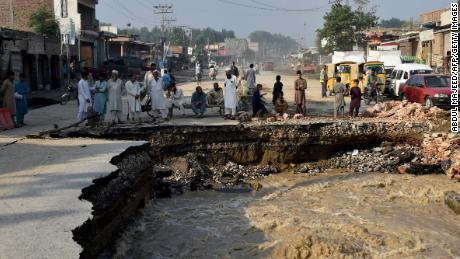Climate Change Minister Sherry Rehman said on Sunday the unprecedented rain had created a “climate disaster” with floodwaters submerging homes, destroying farmland and displacing millions of people.
“We had to deploy the navy for the first time to operate in Indo-Pakistan, because much of it looks like a small ocean,” she told German broadcaster Deutsche Welle.
On Monday, the death toll reached 1,061 since mid-June, according to the National Disaster Management Agency (NDMA), as continued rain raised fears of more deaths to come.
“By the time all of this is over, we may well have a quarter or a third of Pakistan under water,” Rehman told Turkish media TRT World on Thursday.
On Monday, new satellite images from Maxar Technologies showed the scale of the disaster – completely submerged homes and fields along the Indus River, as well as the towns of Rajanpur and Rojhan in Punjab, Pakistan’s most populous province.
Video released by the Pakistani military showed troops staging treacherous helicopter rescues of people stranded in floodwaters, including a boy trapped on rocks in the middle of a raging river in the northwestern province of Khyber Pakhtunkhwa .
Rapid flash floods destroyed more than 3,000 kilometers (1,864 miles) of road, 130 bridges and 495,000 houses were damaged, according to the latest NDMA situation report, making access to flooded areas even more difficult.
Foreign Minister Bilawal Butto-Zardari said on Sunday that this year’s monsoon season had been “absolutely devastating”.
“I haven’t seen any destruction or devastation of this magnitude,” Butto-Zardari said. “I find it very difficult to put into words the phraseologies we are used to, whether it’s monsoon rains or floods, it doesn’t quite seem to sum up the devastation and disaster in classes we still attend.”
A national calamity
After meeting with ambassadors and diplomats in Islamabad on Friday, he appealed for help from the international community.
On Monday, Peter Ophoff, the IFRC’s chief delegate in Pakistan, said the aid network had appealed for more than $25 million to provide emergency assistance to around 324,000 people in the country.
“Looking at the incredible damage the floods have caused, it is slowly becoming clear to us that relief efforts are going to take a very long time. There is going to be a long waterlogged road as the people of Pakistan begin their journey back to what’s left of their homes,” Ophoff said.
More than 3.1 million people have been displaced by ‘sea-like’ floodwaters that have damaged more than half a million homes in several districts across the country, according to a statement released on Saturday by the International Federation of Human Rights. Red Cross and Red Crescent Societies (IFRC).
Abrar ul Haq, chairman of the Pakistan Aid Network, said Friday that water was not the only challenge for aid workers in the region.
“These torrential floods have severely restricted transport and mobility. The threat of Covid-19 and damage to vehicles, infrastructure and connectivity further render our emergency relief work almost impossible. Most of those affected are also immobile or stuck, making it difficult for us to reach,” he said.
“The Monstrous Monsoon of the Decade”
Pakistan is already grappling with its eighth round of monsoon rains, Rehman said Thursday, an anomaly in a country that usually experiences three or four periods of rain a year.
“Pakistan is experiencing one of the most severe climate disasters in the world,” Rehman said in a video statement.
“We are at this point zero of the front line of extreme weather events, which we have seen since the beginning of this year from a relentless cascade of heat waves, wildfires, flash floods, multiple glacial lake blast events and now the monstrous monsoon of the decade.”
In his comments on Sunday, Butto-Zardari said Pakistan was bearing the brunt of climate change while other countries with bigger carbon footprints were doing little to reduce their emissions.
“Pakistan contributes negligibly to the overall carbon footprint, but we are devastated by climate disasters such as these time and time again, and we have to adapt within our limited resources,” he said. declared.


